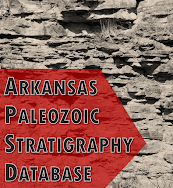The Arkansas Paleozoic Stratigraphy Database is live!

A new project I've been working on is now on the blog: the Arkansas Paleozoic Stratigraphy Database . This is a searchable database of the Paleozoic lithostratigraphic nomenclature in Arkansas with some related information. Within this database, you can search for stratigraphic names that not only are currently in use, but names that are now abandoned and replaced, as well as some that have recently been proposed. For each name you can find its age, any sub-divisions, proper usage as used by the USGS and AGS, historical usage (including past and present names), type locality or type area, type section location (if available), primary reference section location (if available), geographic distribution, etymology of the name, and citation of the original publication the name was used in. Also included for each name is a downloadable stratigraphic chart (PDF file) of either the Ozark or Ouachita/Arkansas River Valley region (whichever the unit is best exposed in) that illustrates the s...